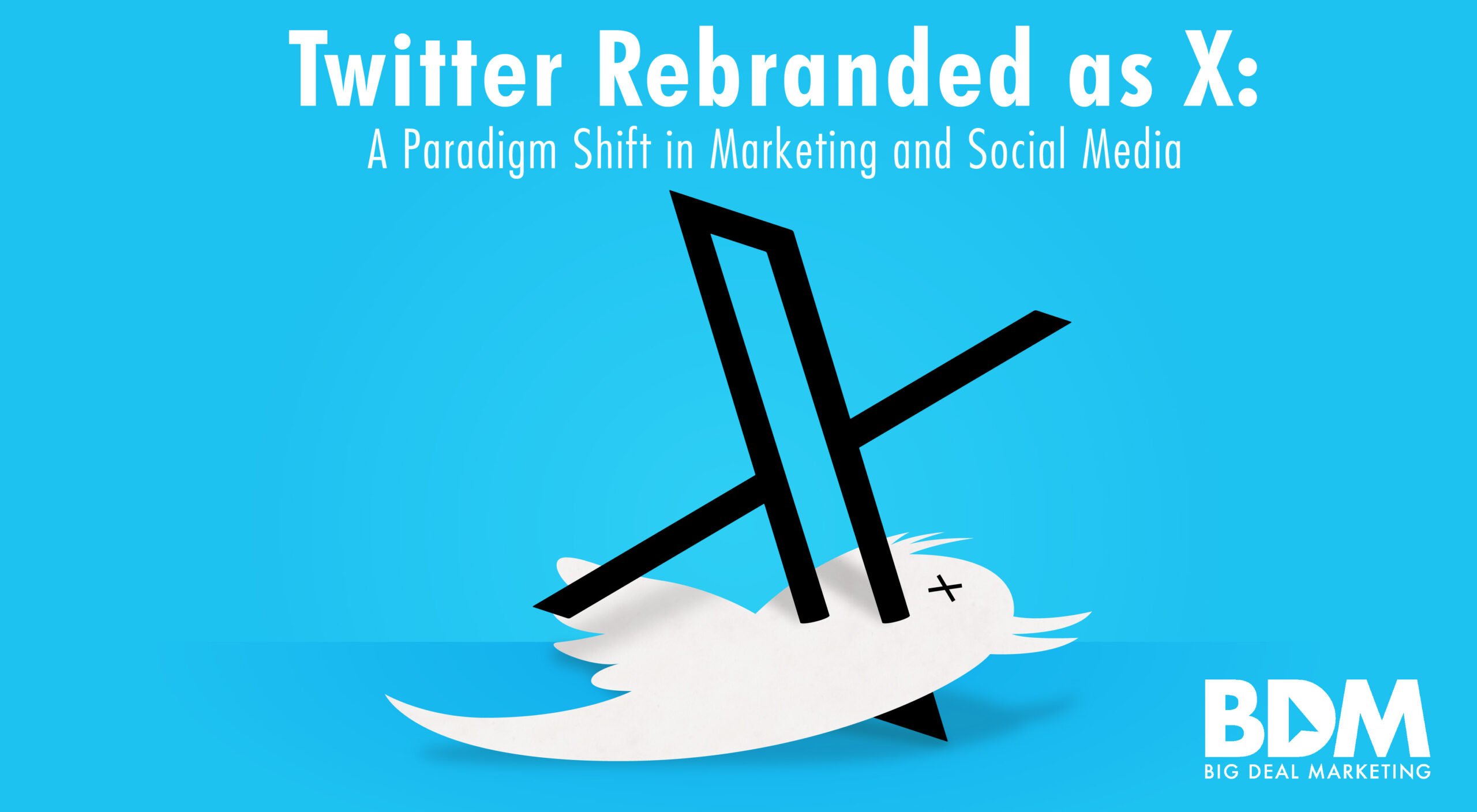In a surprising and bold move, Twitter, one of the pioneers of social media, has announced a significant rebranding effort, changing its name to “X.” This transformation, while unexpected, holds substantial implications for the world of marketing and social media as a whole. This blog post explores the reasons behind this shift and what it could mean for marketers and the broader landscape of online interaction.

The Why Behind the Change: A New Identity for a New Era
Amidst the dynamic shifts of the ever-evolving digital landscape, Twitter’s decision to embark on a rebranding journey, unveiling its new identity as “X,” is pivotal. The iconic status of its former name was undeniable, yet it had gradually become intertwined with the notion of 280-character limitations and an overwhelming influx of information. This strategic rebranding is a bold declaration of the platform’s aspiration to transcend these boundaries. With an eye toward the future, “X” signals an earnest commitment to embracing a horizon of boundless possibilities, fostering inclusivity, and fostering innovation in ways that resonate far beyond characters. Furthermore, the motivation behind this shift might have drawn inspiration from the triumph of another social media platform’s rebranding endeavor. Consider TikTok, which initially operated under the moniker Music.ly. Following its transformative rebrand, TikTok experienced an extraordinary surge in growth and popularity. This is a compelling example of how strategic rebranding can galvanize a platform’s trajectory, driving it toward newfound success and resonance with its target audience. Adding another layer of intrigue is the significance woven into the very fabric of “X,” a motif frequently woven into Musk’s ventures close to his heart. Much like its mathematical counterpart, “X” becomes a symbol denoting an expanse of limitless potentialities, infusing his endeavors with a sense of boundless horizons and uncharted innovation.

Reactions to X
Upon Elon Musk’s revelation of the rebranding to “X,” the immediate reaction from various quarters was a mix of surprise, skepticism, and even disappointment. Social media platforms were abuzz with discussions as users debated the departure from the well-established Twitter name and the potential confusion the new identity might bring. Critics pointed out that “X” lacked the clarity and distinctiveness of other successful rebrands. Additionally, some investors expressed concerns about how this abrupt shift might impact the platform’s stock value and market perception. While Musk’s vision often leads to groundbreaking innovations, the initial reception of “X” seemed to underscore the challenges of departing from a familiar and iconic brand identity. In the end, owing to Twitter’s profoundly entrenched culture and firmly established brand identity, the revelation of the rebrand has evoked sentiments of sadness, anger, and bewilderment within the community.

Big Deal Marketing Reacts to “X”
In the heart of Northwest Arkansas, the social media aficionados at Big Deal Marketing have weighed in on the unfolding drama. A team member candidly shared, “When we heard Elon Musk had bought Twitter, it was unexpected since Elon Musk has the ability and money to start his social media from scratch.” Reflecting on the user experience, a resounding 80% of the team members, when asked, expressed that their interaction with Twitter had taken a downturn since the platform changed hands. Turning to the subject of the name alteration, one team member passionately remarked, “Doing away with iconic branding to stroke one’s ego should be a crime.” This sentiment mirrors the chorus of opinions circulating across online conversations. In a resounding landslide, almost all staff at BDM voted that they were “very unlikely” to refer to Twitter as “X.” The legacy of “Twitter” seems entrenched, a testament to its profound impact, even as the landscape of social media embarks on novel expeditions. The change has had all of us in a bit of bewilderment.

Change is in the Air
Elon Musk encourages embracing change, but it’s important to question the reasons behind such changes. In the last year, platforms like Facebook and Instagram (now part of Meta) have incorporated various new features, many of which were borrowed from competing platforms. To illustrate, Facebook Messenger introduced end-to-end encryption to rival WhatsApp, Instagram and Facebook adopted stories to compete with Snapchat, and video reels were introduced as a response to TikTok’s popularity.
Recently, TikTok launched TikTok Now, a feature enabling users to take pictures using both front and back cameras, triggered by notifications. This addition was meant to compete with BeReal. Amid this rush to add features and replicate one another, these platforms often overlook the initial appeal that drew users in – the distinct user experience they offered compared to others.
While Elon Musk contends that expanding Twitter’s features will encourage inclusivity and creativity, past instances with platforms like Vine, BeReal, and Snapchat show that setting limitations within an app can stimulate users to think more creatively when boundaries are in place. Perhaps Musk’s point is that by expanding features, the doors are opened for marketers and advertisers to promote their content, ultimately driving revenue for X Corp.

The Twitter Killer
Amid Twitter’s recent instability, Meta has launched Threads, a platform dubbed as the “Twitter Killer.” Remarkably similar to Twitter in almost every aspect, Threads now resembles Twitter more than the current version of Twitter itself, especially given Musk’s recent changes to X. Within its initial months, Threads has attracted over a hundred million users. However, despite its success, the app still lacks authentic content and genuine human interactions that are found on other platforms. A significant portion of its posts are generated by marketers and businesses, and many posts lack any type of engagement. At present, Threads resembles a movie set crafted to imitate reality, but behind its Twitter-like appearance, there isn’t substantial activity taking place. Having said that, it is still a platform to keep an eye on as it evolves and creates a solid foundation of users.
Our Conclusion
The transformation of Twitter into X symbolizes the intricate nature of change in the digital era. It represents a desire for innovation while simultaneously confronting crucial inquiries about identity and upheaval. As both marketers and users, we must venture into this unfamiliar domain with a blend of positivity and caution, welcoming the possibilities for advancement while staying aware of the obstacles on the horizon. In the end, the shift from Twitter to X underscores the ever-changing nature of the online realm and the adaptability needed to navigate its unfamiliar challenges. Ultimately, regardless of platforms incorporating all available features, users still gravitate towards distinct platforms for specific reasons, and their respective audiences tend to remain consistent. This intricate dance between user preferences and platform offerings underscores the diverse and ever-evolving nature of our digital landscape. As the digital realm continues to expand, it’s clear that the unique experiences and value propositions offered by various platforms will continue to shape users’ interactions and choices. In this dynamic environment, the key lies in understanding these nuanced preferences and crafting strategies that leverage the strengths of each platform to engage with audiences effectively.



0 Comments